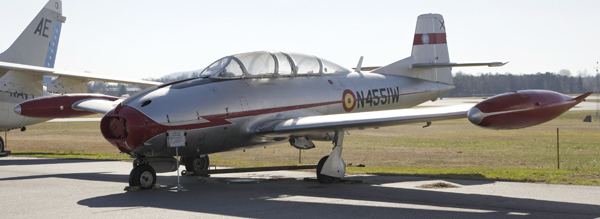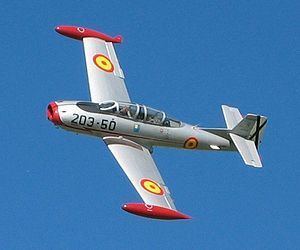Wingspan 11 m Introduced 1962 First flight 1955 | Length 8.92 m Engine type Turbomeca Marboré Number of seats 2 | |
 | ||
Manufacturers Hispano Aviación, Helwan Air Works | ||
The Hispano HA-200 Saeta was a 1950s Spanish two-seat advanced jet trainer produced by Hispano Aviación. It was later developed into the Hispano Aviación Ha-220 "Super Saeta" which was given an attack capability.
Contents

Design and development

The HA-200 Saeta (Arrow) was the first Spanish turbojet aircraft. It was designed by Willy Messerschmitt as the earlier piston-powered trainer HA-100 Triana. The HA-200 was a low-winged monoplane of all metal construction, with a tricycle undercarriage. It was powered by two Turbomeca Marboré mounted side by-side in the forward fuselage and fed from an intake in the nose, exhausting from nozzles just aft of the wing trailing edge. The crew of two was accommodated in tandem in a pressurized cockpit, the first to be Spanish built and designed.

The prototype first flew on 12 August 1955, and the first production aircraft flew in October 1962. The HA-200A aircraft were delivered to the Spanish Air Force with the designation E.14. A single seat version (the HA-220) for the ground-attack role was developed and delivered to the Spanish Air Force with the designation C.10, first flying on 25 April 1970, remaining in service until the end of 1981.
The aircraft was built in Egypt under license as the Helwan HA-200B Al-Kahira by the Helwan Air Works.
Operational history

In 1970, the HA-200 replaced the aging CASA 2.111 (a Spanish development of the Heinkel He-111) in Escuadrón 462 on the Canary Islands. From there they flew on detachments to Spanish Sahara. Late in 1974, during the Polisario uprisings, the planes flew their first combat missions. Polisario Front guerillas ambushed a police patrol from higher ground and caves, and held them pinned from their protected positions. Several T-6Ds with machine guns and a couple of UH-1 helicopters strafed the Polisario positions but with little effect. Very soon the first two Saetas arrived with 2.75" FFARs. Diving at a 45 degree angle toward the cave entrances, the stability of the HA-200 design proved itself without a doubt, as the rockets were observed flying straight into the caves. Following the initial rocket attacks, ground troops attempted to take the caves, but were pushed back.
The next morning, the Saetas arrived once more, in the company of more T-6s and UH-1 troop carriers. The attack pattern from the previous day proved itself once more, with a Forward Air Controller ordering fire where it would be most useful. Rockets entered the caves through the 5–10 foot entrances, with very few missing their target. It seems one of the rockets set off some mortar rounds, as there were several very large explosions. Soon, ground troops once again attempted to take the caves, but this time there was hardly any resistance. Most of the guerillas had been killed by the rockets from the Saetas.
Variants
Operators
Specifications (HA-200E)
Data from Jane's All The World's Aircraft 1965-66
General characteristics
Performance
Armament
